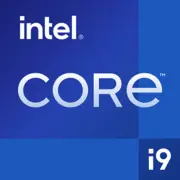Intel Core i9-13980HX vs Apple M2 Max
CPU Comparison Result
Below are the results of a comparison of
Intel Core i9-13980HX
and
Apple M2 Max
processors based on key performance characteristics, as well as power consumption and much more.
Advantages
- More Total Cores: 24 (24 vs 12)
- Newer Launch Date: January 2023 (January 2023 vs January 2023)
- Higher Technology: 5 nm (Intel 7 vs 5 nm)
Basic
Intel
Label Name
Apple
January 2023
Launch Date
January 2023
Mobile
Platform
Laptop
i9-13980HX
Model Name
?
The Intel processor number is just one of several factors - along with processor brand, system configurations, and system-level benchmarks - to be considered when choosing the right processor for your computing needs.
M2 Max
Raptor Lake
Code Name
Apple M2
CPU Specifications
24
Total Cores
?
Cores is a hardware term that describes the number of independent central processing units in a single computing component (die or chip).
12
32
Total Threads
?
Where applicable, Intel® Hyper-Threading Technology is only available on Performance-cores.
12
8
Performance-cores
8
16
Efficient-cores
4
5.60 GHz
Max Turbo Frequency
?
Max Turbo Frequency is the maximum single-core frequency at which the processor is capable of operating using Intel® Turbo Boost Technology and, if present, Intel® Turbo Boost Max Technology 3.0 and Intel® Thermal Velocity Boost. Frequency is typically measured in gigahertz (GHz), or billion cycles per second.
-
-
Performance-core Base Frequency
3.5 GHz
-
Efficient-core Base Frequency
2.4 GHz
Yes
Intel Turbo Boost Max Technology 3.0
?
Intel® Turbo Boost Max Technology 3.0 identifies the best performing core(s) on a processor and provides increased performance on those cores through increasing frequency as needed by taking advantage of power and thermal headroom.
-
5.50 GHz
Intel Turbo Boost Max Technology 3.0 Frequency
?
Intel® Turbo Boost Max Technology 3.0 identifies the best performing core(s) on a processor and provides increased performance on those cores through increasing frequency as needed by taking advantage of power and thermal headroom. Intel® Turbo Boost Max Technology 3.0 frequency is the clock frequency of the CPU when running in this mode.
-
Yes
Intel Hyper-Threading Technology
?
Intel® Hyper-Threading Technology (Intel® HT Technology) delivers two processing threads per physical core. Highly threaded applications can get more work done in parallel, completing tasks sooner.
-
-
L1 Cache
192K per core
-
L2 Cache
32MB shared
36 MB
L3 Cache
-
FCBGA1964
CPU Socket
?
The socket is the component that provides the mechanical and electrical connections between the processor and motherboard.
Apple M-Socket
Intel 7
Technology
?
Lithography refers to the semiconductor technology used to manufacture an integrated circuit, and is reported in nanometer (nm), indicative of the size of features built on the semiconductor.
5 nm
55 W
TDP
70 W
55 W
Processor Base Power
?
The time-averaged power dissipation that the processor is validated to not exceed during manufacturing while executing an Intel-specified high complexity workload at Base Frequency and at the junction temperature as specified in the Datasheet for the SKU segment and configuration.
-
45 W
Minimum Assured Power
-
157 W
Maximum Turbo Power
?
The maximum sustained (>1s) power dissipation of the processor as limited by current and/or temperature controls. Instantaneous power may exceed Maximum Turbo Power for short durations (<=10ms). Note: Maximum Turbo Power is configurable by system vendor and can be system specific.
-
100°C
Max. Operating Temperature
?
Junction Temperature is the maximum temperature allowed at the processor die.
-
5.0 and 4.0
PCI Express Version
?
PCI Express Revision is the supported version of the PCI Express standard. Peripheral Component Interconnect Express (or PCIe) is a high-speed serial computer expansion bus standard for attaching hardware devices to a computer. The different PCI Express versions support different data rates.
-
20
Number of PCI Express Lanes
?
A PCI Express (PCIe) lane consists of two differential signaling pairs, one for receiving data, one for transmitting data, and is the basic unit of the PCIe bus. Max # of PCI Express Lanes is the total number of supported lanes.
-
64-bit
Instruction Set
?
The instruction set is a hard program stored inside the CPU that guides and optimizes CPU operations. With these instruction sets, the CPU can run more efficiently. There are many manufacturers that design CPUs, which results in different instruction sets, such as the 8086 instruction set for the Intel camp and the RISC instruction set for the ARM camp. x86, ARM v8, and MIPS are all codes for instruction sets. Instruction sets can be extended; for example, x86 added 64-bit support to create x86-64. Manufacturers developing CPUs that are compatible with a certain instruction set need authorization from the instruction set patent holder. A typical example is Intel authorizing AMD, enabling the latter to develop CPUs compatible with the x86 instruction set.
-
Up to 1x16+4 | 2x8+4
PCI Express Configurations
?
PCI Express (PCIe) Configurations describe the available PCIe lane configurations that can be used to link to PCIe devices.
-
Memory Specifications
Up to DDR5 5600 MT/s Up to DDR4 3200 MT/s
Memory Type
?
Intel® processors come in four different types: Single Channel, Dual Channel, Triple Channel, and Flex Mode. Maximum supported memory speed may be lower when populating multiple DIMMs per channel on products that support multiple memory channels.
LPDDR5-6400
192 GB
Max Memory Size
?
Max memory size refers to the maximum memory capacity supported by the processor.
96GB
2
Memory Channels
?
The number of memory channels refers to the bandwidth operation for real world application.
8
89.6 GB/s
Max Memory Bandwidth
?
Max Memory bandwidth is the maximum rate at which data can be read from or stored into a semiconductor memory by the processor (in GB/s).
-
GPU Specifications
Intel® UHD Graphics for 13th Gen Intel® Processors
Integrated Graphics Model
?
An integrated GPU refers to the graphics core that is integrated into the CPU processor. Leveraging the processor's powerful computational capabilities and intelligent power efficiency management, it delivers outstanding graphics performance and a smooth application experience at a lower power consumption.
True
1.65 GHz
Graphics Frequency
?
Graphics max dynamic frequency refers to the maximum opportunistic graphics render clock frequency (in MHz) that can be supported using Intel® HD Graphics with Dynamic Frequency feature.
-
12.1
DirectX Support
?
DirectX* Support indicates support for a specific version of Microsoft’s collection of APIs (Application Programming Interfaces) for handling multimedia compute tasks.
-
32
Execution Units
?
The Execution Unit is the foundational building block of Intel’s graphics architecture. Execution Units are compute processors optimized for simultaneous Multi-Threading for high throughput compute power.
-
4096 x 2160 @ 60Hz
Max Resolution (HDMI)
?
Max Resolution (HDMI) is the maximum resolution supported by the processor via the HDMI interface (24bits per pixel & 60Hz). System or device display resolution is dependent on multiple system design factors; actual resolution may be lower on your system.
-
7680 x 4320 @ 60Hz
Max Resolution (DP)
?
Max Resolution (DP) is the maximum resolution supported by the processor via the DP interface (24bits per pixel & 60Hz). System or device display resolution is dependent on multiple system design factors; actual resolution may be lower on your system.
-
5120 x 3200 @ 120Hz
Max Resolution (eDP - Integrated Flat Panel)
?
Max Resolution (Integrated Flat Panel) is the maximum resolution supported by the processor for a device with an integrated flat panel (24bits per pixel & 60Hz). System or device display resolution is dependent on multiple system design factors; actual resolution may be lower on your device.
-
4
Number of Displays Supported
-
eDP 1.4b | DP 1.4a | HDMI 2.1
Graphics Output
?
Graphics Output defines the interfaces available to communicate with display devices.
-
Miscellaneous
Yes
Intel Deep Learning Boost (Intel DL Boost) on CPU
?
A new set of embedded processor technologies designed to accelerate AI deep learning use cases. It extends Intel AVX-512 with a new Vector Neural Network Instruction (VNNI) that significantly increases deep learning inference performance over previous generations.
-
Yes
Intel Virtualization Technology (VT-x)
?
Intel® Virtualization Technology (VT-x) allows one hardware platform to function as multiple “virtual” platforms. It offers improved manageability by limiting downtime and maintaining productivity by isolating computing activities into separate partitions.
-
Yes
Intel Virtualization Technology for Directed I/O (VT-d)
?
Intel® Virtualization Technology for Directed I/O (VT-d) continues from the existing support for IA-32 (VT-x) and Itanium® processor (VT-i) virtualization adding new support for I/O-device virtualization. Intel VT-d can help end users improve security and reliability of the systems and also improve performance of I/O devices in virtualized environments.
-
Intel® SSE4.1 | Intel® SSE4.2 | Intel® AVX2
Intel Standard Manageability (ISM)
?
Intel® Standard Manageability is the manageability solution for Intel vPro® Essentials platforms and is a subset of Intel® AMT with out-of-band management over Ethernet and Wi-Fi, but no KVM or new life cycle management features.
-
36 MB Intel® Smart Cache
Cache
?
CPU Cache is an area of fast memory located on the processor. Intel® Smart Cache refers to the architecture that allows all cores to dynamically share access to the last level cache.
-
Yes
Intel High Definition Audio
-
Yes
Intel AES New Instructions
?
Intel® AES New Instructions (Intel® AES-NI) are a set of instructions that enable fast and secure data encryption and decryption. AES-NI are valuable for a wide range of cryptographic applications, for example: applications that perform bulk encryption/decryption, authentication, random number generation, and authenticated encryption.
-
Yes
Intel Volume Management Device (VMD)
?
Intel® Volume Management Device (VMD) provides a common, robust method of hot plug and LED management for NVMe-based solid state drives.
-
Yes
Intel Boot Guard
?
Intel® Device Protection Technology with Boot Guard helps protect the system’s pre-OS environment from viruses and malicious software attacks.
-
Yes
Intel VT-x with Extended Page Tables (EPT)
?
Intel® VT-x with Extended Page Tables (EPT), also known as Second Level Address Translation (SLAT), provides acceleration for memory intensive virtualized applications. Extended Page Tables in Intel® Virtualization Technology platforms reduces the memory and power overhead costs and increases battery life through hardware optimization of page table management.
-
Yes
Intel Flex Memory Access
-
Yes
Intel OS Guard
-
4.6
OpenGL Support
?
OpenGL (Open Graphics Library) is a cross-language, multi-platform API (Application Programming Interface) for rendering 2D and 3D vector graphics.
-
3.0
OpenCL Support
?
OpenCL (Open Computing Language) is a multi-platform API (Application Programming Interface) for heterogeneous parallel programming.
-
Yes
Intel Quick Sync Video
?
Intel® Quick Sync Video delivers fast conversion of video for portable media players, online sharing, and video editing and authoring.
-
Benchmarks
Geekbench 6 Single Core
Core i9-13980HX
2685
+1%
Apple M2 Max
2656
Geekbench 6 Multi Core
Core i9-13980HX
14881
+4%
Apple M2 Max
14358
Geekbench 5 Single Core
Core i9-13980HX
1978
Apple M2 Max
2004
+1%
Geekbench 5 Multi Core
Core i9-13980HX
19410
+29%
Apple M2 Max
15030
Passmark CPU Single Core
Core i9-13980HX
4315
+4%
Apple M2 Max
4144
Passmark CPU Multi Core
Core i9-13980HX
47536
+78%
Apple M2 Max
26645










